<< Previous | Displaying results 4561-4570 of 6776 for "" | Next >>
Klara Taussig and Ernst Brecher go on an outing in the Austrian countryside before their marriage. They later had a son, Heinz, who was born on August 29, 1932 in Graz, Austria. where his father was a merchant. After the Germans annexed Austria in 1938, Klara and Ernst sent Heinz to live with friends of an aunt in Zagreb. Heinz survived and eventually came to the United States on the Henry Gibbins, a military troop transport. Klara and Ernst died in the concentration camps. Photograph taken…
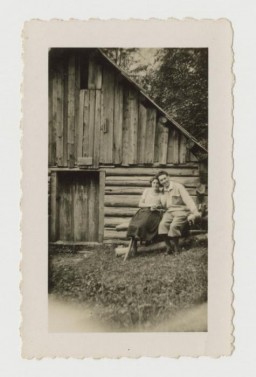
Holocaust survivor Frank Liebermann has a conversation with his teddy bear. Germany, 1933–35. On Frank Liebermann’s first day of school in Gleiwitz, Germany, in 1935, he reported to one of the few small classrooms set aside for Jews. After school, he rushed home to avoid antisemitic attacks. In 1936, it got worse. Anti-Jewish laws now banned Frank from playgrounds and swimming pools. The family decided it was time to leave and applied for US visas. They were lucky. In October 1938, the…
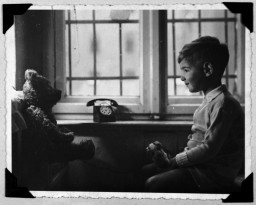
Benjamin Kedar (born Villiam Krausz) sits with a doll and a teddy bear shortly before his family went into hiding. Villiam's parents married in Prague and settled in Nitra, Slovakia. They worked as physicians. They had a daughter, Helen, in 1934, and Villiam in 1938. In 1942 the family relocated to a nearby village until September 1944. At that point, they went into hiding with Slovak peasants to avoid deportation to Auschwitz. Villiam, his sister, and his parents survived the…
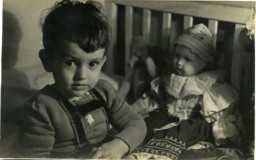
Robert Coopman was born in the Netherlands in September 1940. This 1941 photograph shows Robert holding a telephone while sitting next to a teddy bear. He and his parents lived in Amsterdam where his father was a salesman and bookkeeper. In July 1942, fearing for their safety, Robert's parents placed him in hiding with the Viejou family in Naarden. He was less than two years old. He lived as a member of the household until August 1944, when a neighbor betrayed them. Robert was …
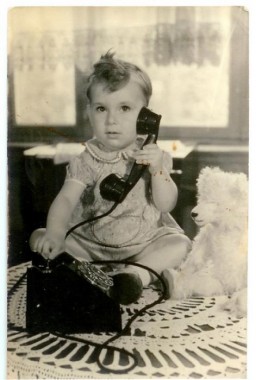
Trench warfare is one of the iconic symbols of World War I. This photograph shows British troops carrying boards over a support line trench at night during fighting on the western front. Cambrai, France, January 12, 1917.
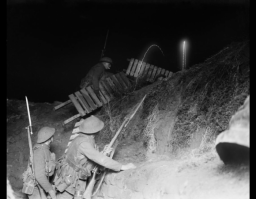
Herta Oberheuser was a physician at the Ravensbrück concentration camp. She performed medical experiments. She was found guilty of performing sulfanilamide experiments, bone, muscle, and nerve regeneration and bone transplantation experiments on humans, as well as of sterilizing prisoners. This portrait of Herta Oberheuser was taken when she was a defendant in the Medical Case Trial at Nuremberg.
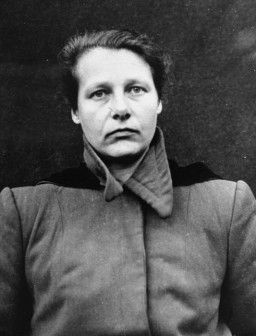
Oskar Schindler plants a tree on the Avenue of the Righteous Among the Nations at Yad Vashem. The Righteous Among the Nations are non-Jewish invididuals who have been honored by Yad Vashem, Israel's Holocaust memorial, for risking their lives to aid Jews during the Holocaust.
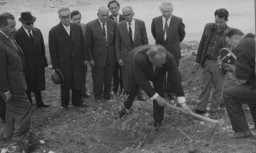
Scene during a visit by SS officer Theodor Eicke to the Lichtenburg camp in March 1936. Lichtenburg was one of the first concentration camps established in Germany were established soon after Hitler's appointment as chancellor in January 1933. When SS chief leader Heinrich Himmler centralized the administration of the concentration camps and formalized the camp system, he chose SS Lieutenant General Theodor Eicke for the task. Himmler appointed him Inspector of Concentration Camps, a new section of the…
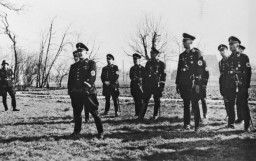
View of the charred remains of Jewish victims burned by the Germans near the Maly Trostinets concentration camp. Photograph taken ca. 1944. In the fall of 1943, the Germans destroyed the Minsk ghetto. The SS deported some Jews from Minsk to the Sobibor killing center, and killed about 4,000 remaining Jews at Maly Trostinets.
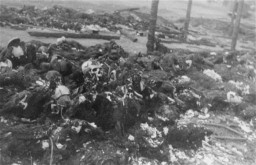
25th Nazi propaganda slide for a Hitler Youth educational presentation in the mid-1930s. The presentation was entitled "5000 years of German Culture." This slide references Lebensraum (the need for living space) in German history: "Wachsende Volkszahl im fargen Nordland zwang neuen Lebensraum zu suchen. Das innerlich morsche Römerreich bricht im Ansturm der Germanen zusammen." Translated as: "Growing numbers of people in Nordland were forced to look for a new habitat. The inwardly…

We would like to thank Crown Family Philanthropies, Abe and Ida Cooper Foundation, the Claims Conference, EVZ, and BMF for supporting the ongoing work to create content and resources for the Holocaust Encyclopedia. View the list of donor acknowledgement.